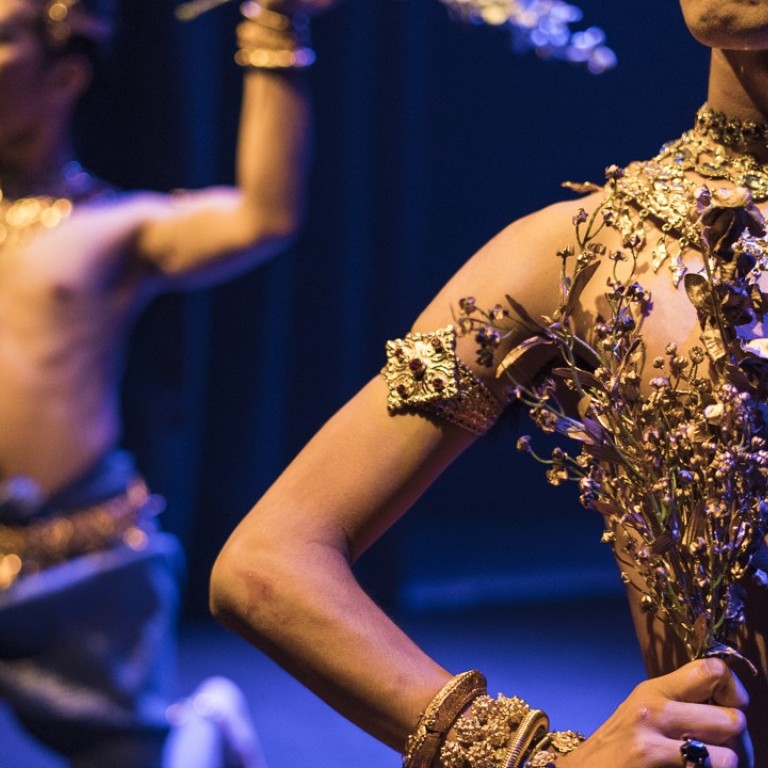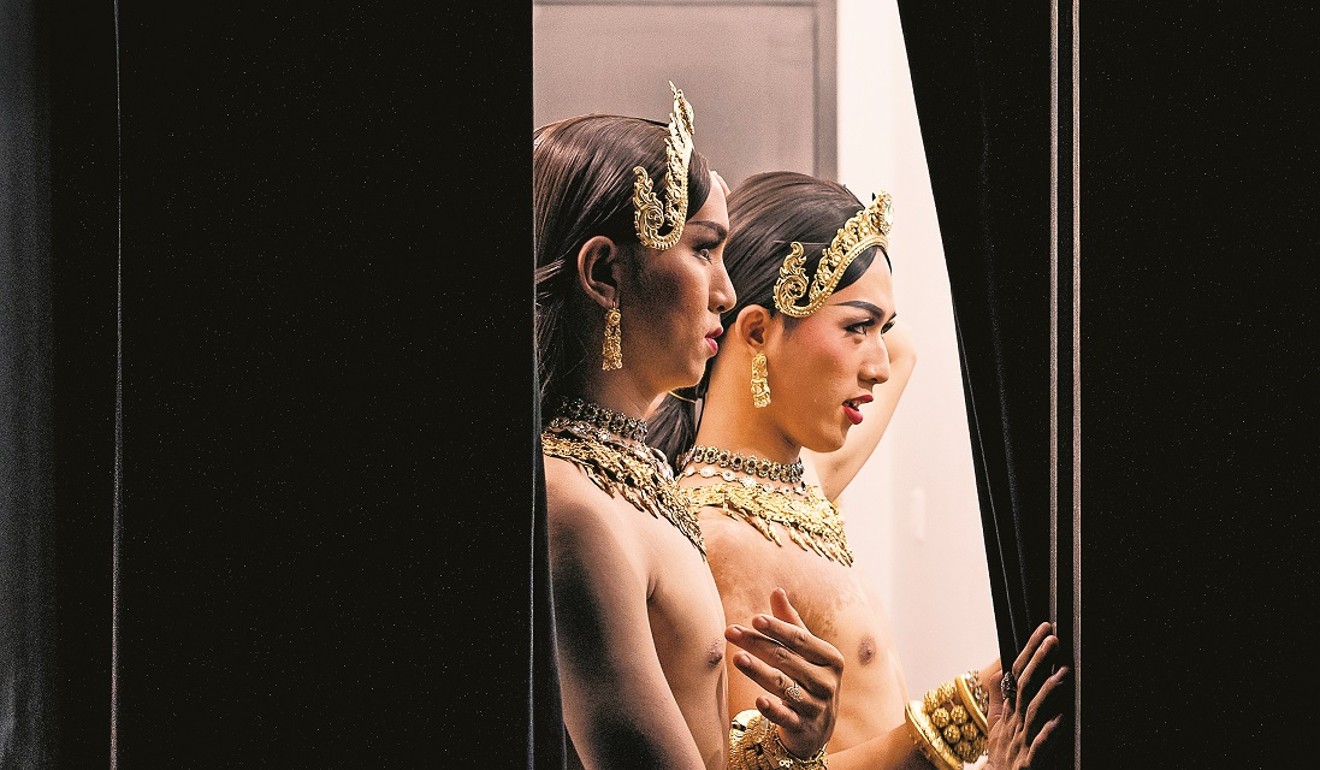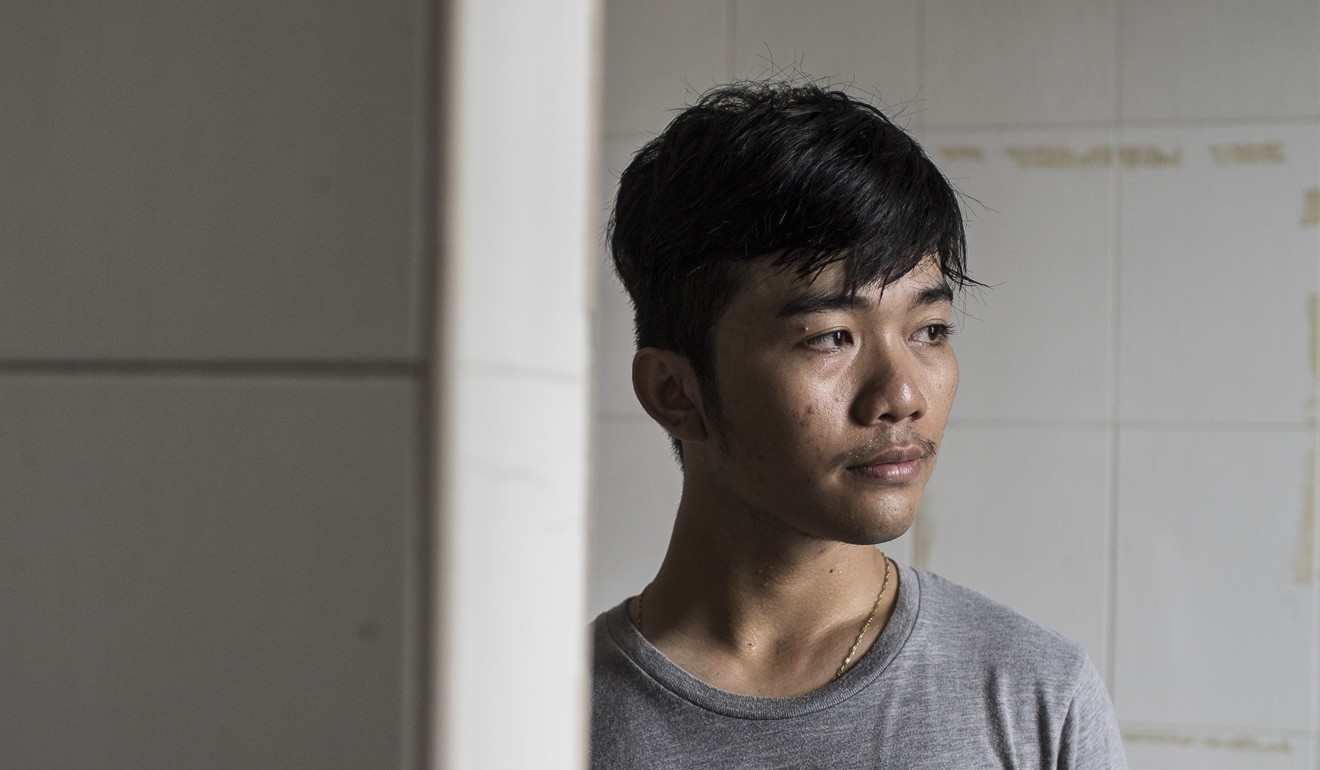
Sam Smith meets sacred in gay troupe’s apsara dance – ‘This is the new Cambodia, inclusive, compassionate and brave’
Cambodian American upended 1,400 years of tradition by using gay men to portray apsaras – celestial nymphs who seduce mortals with their beauty – in classical dance. Their mould-breaking show is winning recognition and fans
A slender silhouette appears onstage. Black hair dotted with flowers tumbles down an arched back. Jewels glitter from the wrists of outstretched arms, the fingers gently curved back in a gesture that is synonymous with Cambodian classical dance. Ching (finger cymbals) chime as the dancer begins the graceful movements that once mesmerised Angkorian kings.
This is a dance that has been performed for more than 1,000 years. An art considered to be of the highest form, performed by females who entertained royalty inside the walls of Angkor, the ancient Cambodian temple city. A spotlight shines on the dancer, highlighting piercing red lipstick, smoky eyes, a crown of jewels and intricate silk costume.
As the figure flutters across the stage, something quickly becomes apparent. The silk sash draped across a naked torso reveals this to be a troupe that has taken tradition and brought it into the modern world. This is Cambodia’s first gay dance company – a group of six young men that goes by the name Prumsodun Ok & Natyarasa and whose members are breaking down barriers through their work.
“We want to give new life to this ancient tradition by preserving what was given to us and to reimagine that tradition, create new works, new costumes, new dances,” says the group’s leader, Cambodian-American Prumsodun Ok, or Prum, who is a TED Fellow.
“In that process, create a new face of Cambodia; one that goes beyond genocide, beyond poverty and tragedy. Yes, that history still affects Khmer people, but that’s not all we are,” he says.

Cambodian classical dance – often referred to as apsara dance – is one of the country’s most treasured ancient art forms, with a history stretching back to the 7th century. More than 1,800 images of the ethereal beings decorate the temple walls at Angkor.
In Hindu culture, an apsara is a female spirit of the clouds and water; a celestial nymph and passenger between heaven and Earth so stunning she can seduce mortals with her beauty. By tradition, in dance they are represented by women and girls. Prum upended that tradition when he launched his company in 2016.
Royal Ballet of Cambodia: a princess brings sacred dance to the masses
“There are studies that show PTSD [post-traumatic stress disorder] can be passed on genetically,” says the 31-year-old. “If trauma can be passed on, why [not] knowledge and love, beauty, hope and resilience? Why can’t that be the narrative of Cambodia?
“When we perform internationally, we show people this is the beauty of Cambodia and resilience of our people. This is the new Cambodia, the future of Cambodia, and the future of Cambodia is inclusive, compassionate and brave.”

Prum was born in California to Cambodian parents who fled the genocidal Khmer Rouge regime that ruled the country between 1975 and 1979 and under whom up to a quarter of the population died or were killed. At the age of four, he was introduced to Cambodian classical dance when his father took him to a temple in Long Beach – home to a large Khmer diaspora – during a festival.
Captivated by the dancers’ grace, Prum watched videos at home, putting on his sister’s dresses and imitating the dance. But the bullies soon ended that.
People say we’re destroying this and that, but it’s easy to flip it. Aren’t we brave for doing this and isn’t Cambodia a compassionate society for allowing a group like us to exist?
“For 12 years, I pushed dance away because it was a marker of my femininity,” he says. “Kids used to call me faggot and things like that, so for my own sanity and safety I had to protect myself.”
At the age of 16, his sister started attending dance classes, with Prum watching for a year before plucking up the courage to join. He rapidly rose to the top of the class. “I watched the class and my love for dance flooded my body once again,” he says.
In 2015, he received funding to develop a work in Cambodia, Beloved, which proved to be the inspiration for Prumsodun Ok & Natyarasa. Wanting to cast gay men for the piece, based on a 13th century legend in which a king makes love nightly to a naga, a mythical, many-headed serpent, Prum opened auditions in the front room of his apartment in the Cambodian capital, Phnom Penh, which today doubles as the company’s studio.
He was overwhelmed by the response. Twelve men auditioned, of which he selected five. Two remain with the company today.

Prum recruited a further four dancers, designed costumes and reimagined traditional dance through choreography that makes the ancient art form relevant to contemporary Cambodia. For example, dancers glide elegantly across the stage performing traditional moves to Sam Smith’s contemporary soul track Lay Me Down, experimental poetry, and other sounds that serve as the backdrop to remastered Khmer legends. Other ancient tales are retold to traditional music.
Martial art that gave birth to Muay Thai has revival in Cambodia
“When you look at some of the dances, they feel traditional, but [what we do is] extremely radical because this is an art form that’s seen as the highest reflection of beauty and order in Khmer society,” says Prum. “It’s a mirror of heaven, and heaven is society’s highest expression of order. So to make an image of gay love in that is a really strong gesture.”
In summer 2016, Prumsodun Ok & Natyarasa made its debut at the Department for Performing Arts in Phnom Penh to a packed audience. “The dancers were nervous about going on stage with this label. But when we performed, and people saw the quality of the costumes, dancing and choreography, they realised there are new possibilities for this dance form. That demonstrated there is a hunger to see things that are new and truly reflect Cambodia today,” Prum says.

However, the company does have its critics; it has been accused of destroying Khmer culture by casting men – and gay men at that – in traditionally female roles.
“There are a lot of people who don’t understand us or what we’re doing, and use the argument that this is not Khmer, it’s breaking tradition,” says Prum. “They don’t realise tradition is always evolving. People say we’re destroying this and that, but it’s easy to flip it. Aren’t we brave for doing this and isn’t Cambodia a compassionate society for allowing a group like us to exist?”
Sopharoth Morn spent his childhood dreaming of gracing the stage as a classical dancer. “I’ve loved classical dance since I was young,” the 22-year-old says. He recalls being mesmerised by dance on television and enthralled by the costumes, and collecting jewellery in his bedroom.

“Normally this art form is only open to female students and you have to start at a very young age. It was virtually impossible for me to practise this dance professionally.”
In September, his lifelong dream came true when Prum spotted his passion and talent and invited him to join the company. Since then, Sopharoth Morn has travelled to India to perform, and earlier this year Prumsodun Ok & Natyarasa secured a residency at the Java Creative Cafe in Phnom Penh, performing twice weekly.
“I’m proud to be one of the first male dancers in this country. Tradition is tradition, but art doesn’t stay in one place. It has to develop and evolve, and we are creating a contemporary art form for today,” Sopharoth Morn says.

“People criticise us because we are male dancers performing classical dance that’s only for females. I never say anything to them in response, but I work harder and practise harder to show that I can also dance gracefully and that it’s OK to dance this art form.”
Pichoudom Phun is the newest member of the troupe, having joined in May. Following in the footsteps of his grandmother and her forebears, who performed classical dance for Cambodia’s kings at the royal palace – the 22-year-old says he is proud to be championing the art and promoting LGBT rights.
“I love being part of this movement because we queer people have our own voices through dance and many kinds of activism,” he says. “I’m proud to be starting something in a new environment for all the queer people here in Cambodia.

“The younger generation, my generation, are pretty OK with it, but [the] older generations … still need time for that to sink in. We want to show what modern Cambodia is while still preserving tradition.”
With the troupe’s popularity growing, the dancers remain committed to their cause. While external funding is tight, Prum is determined to pursue his project of advocating for LGBT communities across the globe while ensuring one of Cambodia’s most treasured art forms remains alive and relevant, as he sees it.
“I can pay my dancers a proper wage, giving them the resources to live, think, and perform with freedom, dignity, pride and independence,” he says. “I can transform my dancers into artists in their own right, capable of being teachers and ambassadors of the tradition, of LGBT people, of Cambodia, and of a more inclusive world.”
For information about the dance troupe, visit prumsodun.com

